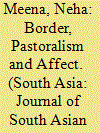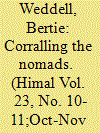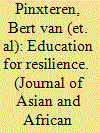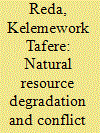|
|
|
Sort Order |
|
|
|
Items / Page
|
|
|
|
|
|
|
| Srl | Item |
| 1 |
ID:
191700


|
|
|
|
|
| Summary/Abstract |
The demarcation of the India–Pakistan border on the western side of Rajasthan in 1947 had profound implications for the pastoral communities there. Based on an archival history of the Thar desert and ethnographic fieldwork in the border villages of Rajasthan, this paper explores how pastoralists interact with the border and the bordering practices of the state. Focusing on the Raika community, the paper examines how borders impact the mobility, identity and traditional life of the pastoralists. Building on Raika memories of mobility and connections across the border, the paper argues that the interactions of the pastoralists maintain an affective relationship with this war and violence affected borderland, despite the administrative practices of surveillance, border maintenance and developmental projects that have produced an environment of insecurity and uncertainty.
|
|
|
|
|
|
|
|
|
|
|
|
|
|
|
|
| 2 |
ID:
192185


|
|
|
|
|
| Summary/Abstract |
In 2018, the Tibet Autonomous Region began resettling pastoralists from high-altitude areas to newly built settlements in distant, lower-altitude farming locations under the “extremely high-altitude ecological resettlement” programme, with a stated dual purpose of environmental protection and improving pastoralist well-being. The programme is said to be based on a principle of “government guidance and voluntary participation.” However, despite its stated “voluntary” nature, the government reports a 100 per cent rate of agreement to participate. After examining the ecological rationales for resettlement and pastoralists’ reluctance to move owing to livelihood concerns and attachment to homeland, the article examines how consent is achieved. Based on official documents and reports as well as semi-structured interviews with officials and pastoralists in Nagchu Municipality, the core target area for the programme, the article identifies a three-step “thought-work” oriented process – beginning with an initial survey, followed by group incentives and warnings and then individual incentives and warnings – which is deployed until pastoralists sign a resettlement agreement. The process illustrates the dialectical relationship between coercion and consent.
|
|
|
|
|
|
|
|
|
|
|
|
|
|
|
|
| 3 |
ID:
100816


|
|
|
| 4 |
ID:
180689


|
|
|
|
|
| Summary/Abstract |
We examined existing problems relevant for education in global drylands and discuss their potential solutions in four fields, crucial for properly functioning educational systems: (a) response to low population densities, (b) governance, (c) language of instruction and (d) mismatch between education and the labour market. Our analysis leads us to the formulation of nine policy recommendations that may help create an educational system that strengthens resilience of dryland communities in the face of ongoing climate change. Our recommendations underline the necessity to combine systemic solutions with bottom-up ideas and extrinsic help coming from involvement of diaspora and non-governmental organizations.
|
|
|
|
|
|
|
|
|
|
|
|
|
|
|
|
| 5 |
ID:
178882


|
|
|
|
|
| Summary/Abstract |
Based mainly on archival and oral sources this study examines the history of the cattle-herding Samburu people from the mid-nineteenth century through Kenyan independence in 1963. The authors emphasize the resilience and resourcefulness that the transhumant pastoralists exhibited as they encountered a host of challenges that ranged from epidemics and major outbreaks of disease among their livestock to interethnic competition for scarce resources to a host of disruptions brought on by colonial rule. The allegedly scientific nostrums British administrators sought to impose engendered a host of innovative reactions and ultimately the Samburu succeeded in abolishing the most onerous of these so that they gained their own kind of independence even before Uhuru came to the rest of Kenya. Thus, the Samburu brand of transhumant pastoralism, which colonial officials and other “expert” observers once believed a curious relic that was destined for the dustbin of history, nonetheless persisted into the post-independence era.
|
|
|
|
|
|
|
|
|
|
|
|
|
|
|
|
| 6 |
ID:
141436


|
|
|
|
|
| Summary/Abstract |
Based on a literature review, this article examines the dynamics in pastoral systems, natural resource conservation and conflict in the drylands of East Africa. It argues that, in the context of East Africa, pastoralism and biodiversity conservation in general are distinct forms of land use that are complementary rather than competitive. The present state of natural resource degradation in the drylands is explained in terms of factors related to ecological and demographic pressures, land use conflicts and inefficient land administration policies. When the customary pastoral institutions of land administration and resource management are threatened, the problem of degradation is further exacerbated and violent conflicts occur among multiple resource users, including pastoralists, farmers and the state. The article recommends the revitalisation, empowerment and recognition of pastoral institutions in a way that ensures effective synergy between the formal and customary structures of resource governance.
|
|
|
|
|
|
|
|
|
|
|
|
|
|
|
|
| 7 |
ID:
175526


|
|
|
|
|
| Summary/Abstract |
In the last few years, several African countries have witnessed an increase in conflict between pastoralists and sedentary farmers and among pastoralist groups. While issues such as climate change, desertification, regional conflicts, population expansion, trafficking and terrorism have been highlighted as the reasons for the surge in violence, none of these issues fully explain the increased use of small and light weapons by several pastoralist groups and sedentary farmers. This article explores the changes in the dynamics of cattle ownership, termed neo-pastoralism, as a possible explanation for the increase in armed clashes between the groups. The article explains how traditional pastoralism is gradually giving way to neo-pastoralism, a form of pastoralism which involves larger herds and increased use of arms and ammunitions. Nigeria is used as a case study to explore these new patterns of conflict due to having the largest number of cattle in the sub-Saharan Africa region and the scale of the conflict in the country. This article is based on field research and interviews carried out in Nigeria between 2013 and 2019.
|
|
|
|
|
|
|
|
|
|
|
|
|
|
|
|
| 8 |
ID:
162540


|
|
|
|
|
| Summary/Abstract |
This paper analyzes the transmission of China’s Ecological Migration Policy from the central government down to Tibetan villages and townships for implementation. It examines the specific ways through which the policy is translated from Chinese to Tibetan and communicated through various local dialects to concerned pastoralists. In order to achieve the Ecological Migration Policy’s purported objectives of environmental conservation, livelihood improvement, and urbanization, township government officials at the grassroots level mistranslate and miscommunicate policy meanings to villagers to render an otherwise unfeasible, impractical policy implementable on the ground. Tibetan pastoralists actively engage with this resettlement project to fulfill their desires and aspirations for accessing healthcare and educational services in urban areas. However, this pursuit of legibility is induced by the state’s negligence of rural pastoralist life and elimination of alternative educational facilities in rural communities. Both negligence and elimination of educational facilities in rural areas concentrate and increase investments in education and healthcare in urban settlements. These conjunctures ultimately drive Tibetan pastoralists to “choose” their only available option, to resettle in urban townships.
|
|
|
|
|
|
|
|
|
|
|
|
|
|
|
|
| 9 |
ID:
192301


|
|
|
|
|
| Summary/Abstract |
Development scholars have noticed the decoupling of rural poverty and well-being from agriculture and other traditional livelihoods, and the greater importance of highly mobile and delocalized livelihoods across the Global South. In this context, the Indian Himalayan state of Himachal Pradesh has been hailed as a development exemplar. While there is undeniable though uneven economic mobility across the state, what of its spatiotemporality? As more capital makes its way to interior regions, where and how is it fixed, and how do these processes reconfigure prevalent rhythms of life? This paper considers the changing materiality of the urbanizing settlement of Bharmour, the centre of the agri-pastoralist Gaddi community in Himachal, alongside the intersecting temporalities experienced by its residents. The pastoralist seasonal time has historically structured the rhythms of the region. Since the late colonial period, but with greater intensity since the 1970s, the state has sought to discipline time through the broader discourse of tribal development. More recently, state-backed capitalism aims to flatten time towards the accelerated circulation of people, information, and commodities. Theorizing spatiotemporality from the perspective of Bharmour shows that despite these changes, pastoralist rhythms continue to shape the settlement, producing a form of the urban the paper terms ‘the seasonal town’.
|
|
|
|
|
|
|
|
|
|
|
|
|
|
|
|
|
|
|
|
|